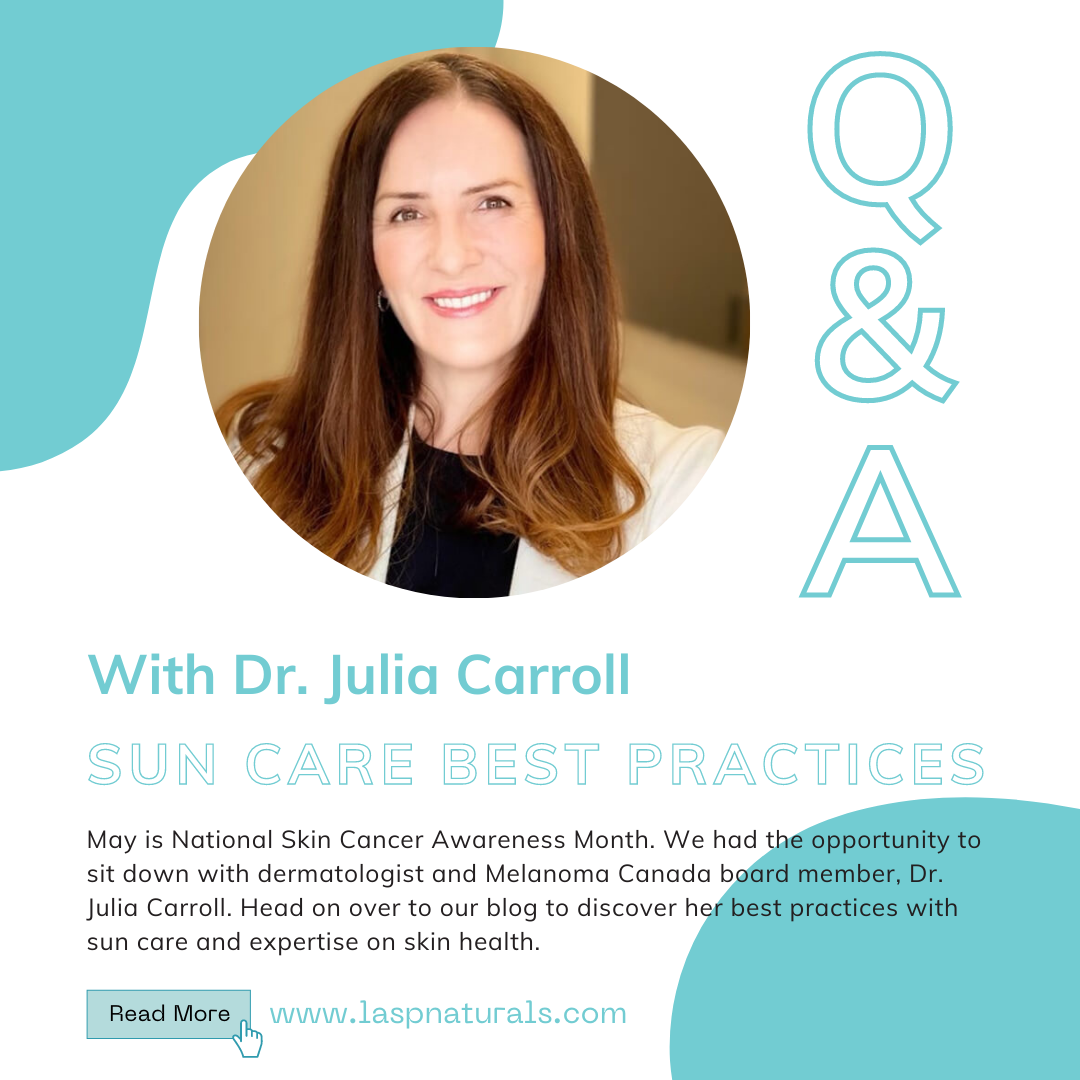

May is National Skin Cancer Awareness Month. As a brand that feels strongly about healthy sunscreen solutions for everyone, we wanted to dive deeper into skin cancer prevention and explore exactly how we can protect ourselves and our loved ones.
We had the opportunity to sit down with dermatologist and Melanoma Canada board member, Dr. Julia Carroll. Read on to discover her best practices with sun care and expertise on skin health.
What are the different types of skin cancer?
There are melanoma and non-melanoma skin cancers.
Melanoma is a malignancy of the melanocytes – the pigment cells that are found in the skin. It’s not the most common but it is the deadliest type of skin cancer.
In terms of non-melanoma skin cancers, there are basal cell carcinomas and squamous cell carcinomas. Basal cell carcinoma is the most common skin cancer and one that traditionally grows locally and doesn’t tend to metastasize.
Squamous cell carcinoma is somewhere in the middle. They’re typically very treatable but if left untreated, they can metastasize and can go on to cause more serious problems.What causes melanoma and other skin cancers to develop?
What causes melanoma and other skin cancers to develop?
85-90% of melanomas are caused by the sun or other forms of UV radiation such as tanning beds. The other major factor is genetics. There are some other possibilities like environmental pollutants but more research is needed to confirm them.
Are there any other risk factors that we should be aware of?
The biggest risk factor is sun exposure. For certain skin cancers, it’s the amount of sun you’ve had over a lifetime. For others, it can be just one bad, blistering sunburn. As an example, one sunburn can increase your risk of melanoma.
It also depends on what type of skin you have. People that have Type 1 Skin (red/blonde hair, blue/green eyes, fair skin, and freckle easily) are at much higher risk for skin cancer.
Certain lifestyle factors will increase your risk of sun exposure. We see it in people who are outdoor workers like farmers or construction workers. Even pilots have an increased risk of skin cancer because they are sitting in front of glass windows every day as they fly.
We’ve also seen higher instances of skin cancer in people who participate in certain sports and outdoor activities like rowing, sailing, and lifeguarding. These are all opportunities where you would have more sun exposure than your average person.
What are the most effective ways to prevent skin cancer?
Melanoma Canada has done a great job of simplifying this with three ways to block the rays.
1. Use a high SPF broad-spectrum sunscreen. As a dermatologist, I put on sunscreen every day. I don’t look at the weather. At 5:00 am in the winter, you’ll still find me applying sunscreen.
2. You can look for clothing that is designed to block the sun such as UPF clothing. This stands for ultraviolet protection factor. Always remember to protect your head. We recommend a hat with a broad rim to provide shade. Sunglasses will protect your eyes and the delicate skin around your eyes. I like to opt for sunglasses that have a wide arm on the side as that adds protection both upfront and along the sides of your face.
3. Avoid the sun during peak hours. In Canada from the months of March-October, we recommend that you seek shade during the hours of 11:00 am and 3:00 pm. If you’re planning a family outing or a sporting event, we recommend you plan it outside of those hours.
How much sunscreen should we be using? How often do we need to reapply?
We recommend an ounce (approximately the size of a shot glass or golf ball) of sunscreen. That should cover your entire body. If you’re participating in an outdoor activity, we recommend you reapply your sunscreen every two hours.
If you’ve applied your high SPF sunscreen and you’re inside all day (not by a window), that morning amount should get you through the day. If you’re driving, going for a walk on a break,
or having lunch on a patio, those are opportunities to reapply sunscreen. If you sweat or get wet, you need to reapply.
What tips do you have on applying sunscreen accurately?
Do it naked. The best time to put sunscreen on is first thing in the morning before you get dressed. If you’re applying your sunscreen once you have your clothing on, you might miss a spot. Don’t forget the tops of the ears and the tops of the feet. Those are common areas we see burns.
Why is zinc oxide a suitable sunscreen ingredient for people with skin sensitivities and allergies?
Zinc oxide is one of the physical sun blockers. Physical sunscreens are products that I recommend on a regular basis. They provide good coverage and protection from the sun.
For some people, chemical sunscreens can be irritating, especially if you have an allergy or sensitivity to chemical sunscreen ingredients. Physical sunscreens are a great choice and people with sensitive skin or rosacea-prone skin tend to do better with physical sunscreens.
How do we incorporate sun care/prevention into our everyday routines?
One of the things that I’ve tried to do with my family is lead by example. I do this by using sunscreen every day, modelling the behaviour, and wearing a hat when we’re doing outdoor activities. I also made sunscreen a part of my daughter’s routine from an early age.
It comes down to finding a product that you like and trust and that you’re willing to use on a daily basis. If you find a product that is suitable for your skin type, it becomes easy to incorporate it daily.
If someone is looking for signs and symptoms of skin cancer, where should they start? What should they be looking for?
For melanomas, we break it down to the A-B-C-D-E’s.
A stands for asymmetry. One side of the mole doesn’t look like the other.
B is the border. You’ll see colours shooting out or a fuzzy border on the mole.
C stands for colour. If the colour is getting darker or is changing, that would be a concern.
D is for diameter. Anything larger than 6mm or approximately the size of a pencil eraser.
E stands for evolution. If you notice any changes to your moles, talk to your family doctor or your dermatologist to get that mole checked out.
Getting a mole checked is an easy process. We examine the mole with a tool called a dermatoscope as well as our naked eye. Most of the time, it’s nothing of concern and we can reassure you.
Basal cell carcinomas will often look like a pearly pink or reddish bump with extra blood vessels around it or it may be a flaky spot in one area that doesn’t go away.
Squamous cell carcinomas can be a bump with a hard spot in it or they could also be a small, flaky, red patch of skin.
Are there any other screening tips that we should be aware of?
Get to know your body and your moles. Statistically, 85% of melanomas are discovered by patients themselves or family members.
Pick a date monthly to examine yourself. For example, my birthday is on the third and so on the third of every month, I get in front of the mirror and take a look at the moles and spots on my body. You can get help from a family member or grab a handheld mirror to look on your back.
Moles are like constellations. Over time, you’ll get to know your moles and the patterns of your moles and you’ll quickly notice if something is new or something has changed.
How often should we be consulting a dermatologist for skin check-ups?
For an average person, a family doctor can perform your skin checks. If the family doctor is unsure, they can send the patient on to a dermatologist.
In Canada, we only have about 600 dermatologists for the entire population. We’re not able to scan every single Canadian on a regular basis. As specialists, we try to reserve our skills for people who have been screened by their family doctor first.
What is the biggest misconception when it comes to skin cancer and sun health?
The biggest misconception is that it’s just skin cancer. People think that if you get skin cancer, you can just cut it out. However, when you look at melanomas, they can be serious and even deadly.
Even something like a basal cell carcinoma requires surgery and sometimes extensive surgery. People can be left with scars. It can be a scary procedure to go through to have skin cancer removed. The best way to deal with that is to get ahead of it and protect yourself from the sun.
About Dr. Julia Carroll
sun Follow Dr. Julia Carroll on Instagram!
Dr. Carroll is an award-winning board-certified dermatologist known for her designer approach to beauty. As a sought-after media personality in the area of cosmetic dermatology and skincare, Dr. Carroll travels worldwide, both lecturing and learning, to bring the latest results-oriented treatments to her patients.
She is the co-founder of Compass Dermatology in downtown Toronto and holds a faculty position within the University of Toronto, Division of Dermatology. Apart from her busy dermatology practice, she is on the board of Melanoma Network Canada. Dr. Carroll completed her dermatology residency at the University of Toronto and is a fellow of the Royal College of Physicians and Surgeons of Canada. Prior to her dermatology training, she completed medical school at Dalhousie University, graduating Alpha Omega Alpha. She also holds a Bachelor of Science from Acadia University. Dr. Carroll is a proud maritimer, avid sailor, and mom. She and her family love exploring the world and spending time on the east coast.

